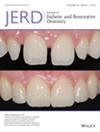Two- and three-dimensional symmetry of maxillary incisors: A clinical study
Abstract
Objective
To assess the 2D and 3D natural symmetry of the maxillary incisors.
Materials and methods
Maxillary alginate impressions were taken of 59 young adult volunteers. Gender, orthodontic treatment history, and dominant hand were collected. For 2D analysis, a digital caliper was used for measurements on maxillary casts. For 3D analysis, the casts were scanned using a lab scanner, and the labial surface symmetry of contralateral incisors was evaluated. Mann–Whitney tests and Student's t-test were performed, α = 0.05.
Results
Results indicated a lack of identical lengths among contralateral central or lateral incisors, with minimal occurrences of identical width measurements. 68% of central incisors and 73% of lateral incisors showed differences in length exceeding 0.2 mm. Central incisors showed more similarities than lateral incisors in width, with 61% central incisors and 47% lateral incisors having differences under 0.2 mm. The differences between highly asymmetrical contralateral teeth are situated at the transitional lines. The influence of sexual dimorphism, orthodontic factors, and the dominant hand on incisors' symmetry was not statistically significant.
Conclusions
2D and 3D symmetry of the natural maxillary incisors are rare. 3D symmetry remains consistent across orthodontic treatment status, gender, and dominant hand, suggesting its independence from such parameters.
Clinical significance
To achieve a natural and aesthetic smile rehabilitation, the symmetry of the maxillary incisors must be well understood. In our study, 2D and 3D symmetry of the maxillary incisors occurred rarely, but central incisors showed more similarities than lateral incisors in width, with differences under 0.2 mm. On the other hand, differences between highly asymmetrical contralateral teeth are situated at the transitional lines. These conclusions should be included in further computer-assisted three-dimensional smile designs.


 求助内容:
求助内容: 应助结果提醒方式:
应助结果提醒方式:


